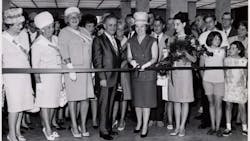Women in Our Industry, Then and Now
This June 23rd marks the 10th anniversary of the first International Women in Engineering Day, which was started by the Women's Engineering Society in the United Kingdom to celebrate its 95th anniversary.
In this, HPAC Engineering’s own 95th year, we honor that progress with our June podcast, where we chat with Nancy Kohout, P.E., LEED AP, chair of the upcoming Women in ASHRAE Leadership Symposium, set for Chicago this September. That conference feels both appropriate and long overdue in 2024. But frankly, women’s progress in this industry, as well as in broader society, has been nothing if not marked by contradictions, fits and starts over the last century.
How so?
Well, in 1916, Margaret Ingels became the first woman in the world to earn a degree in Mechanical Engineering. A year later, she and Helen Innis became the first female members of ASHRAE’s forerunner, the American Society of Heating and Ventilating Engineers. At the time, U.S. women still did not have the right to vote. That right would not come until three years later, when it was enshrined in the 19th Amendment to the U.S. Constitution.
More than a century later, however, ASHRAE, itself, has had just three female presidents in its 130-year history, including Ginger Scoggins, P.E., whose term concludes this June. Of course, that still puts the Society well ahead of the pace of the nation, which has yet to break the glass ceiling in the Oval Office, and that streak is nearing 250 years now!
Today, as young women in the U.S. find themselves re-litigating fights for rights that most thought their mothers and grandmothers had already secured, it is worth appreciating the progressive momentum that is still relatively new to this industry. Within my lifetime, for example, in the pages of this magazine and those of our rivals, women mostly appeared in advertisements and occasional pictures and stories from industry conventions, noting the activities of various Women’s Auxiliary groups.
But women are “auxiliary” no longer.
Still, other challenges remain in an overwhelmingly male-dominated field.
“I sometimes find I am leading meetings where I am the only woman in the room,” notes ASHRAE's Kohout on HPAC On The Air. “In that situation, not only do I have to be technically capable and competent, but for a woman, there’s also an extra lift. I have to be warm. I have to be caring. I have to soften things with humor. I would love to see us not expect that someday. But it is what it is and it’s still there.”
According to Kohout, a principal and mechanical practice lead at SmithGroup in Chicago, “A pivotal way for engineering culture to help close its well-documented gender gap is for more women to emerge as organizational leaders and as mentors for the next generation of female engineering professionals.”
That is the clear goal of the upcoming symposium.
But ASHRAE is far from the only industry group increasing its focus on women this year. In May, the American Boiler Manufacturers Association convened its first Women In the Boiler Industry (WIBI) meeting at BOILER 2024 in Denver. And the U.S. Commerce Dept. also launched a Million Women In Construction Community Pledge, which already has garnered support from seven large industry contractors: Baker Construction; Gilbane Building Co.; Mortenson; McKissack & McKissack; Power Design; and Shawmut Design and Construction.
“Right now, women make up less than 11% of jobs in construction and only 4% in skilled trades,” said Commerce Secretary Gina Raimondo. “If we’re going to meet this moment, we need more women in construction, and we need an industry-wide commitment, which is why I’m calling on everyone — contractors, labor unions, training organizations — to sign on to the Pledge.”
According to the American Society of Mechanical Engineers, women currently make up 14% of U.S. engineers. For perspective, the National Society of Professional Engineers says that total was just 1% in 1963. So, the last half century really has seen considerably more change than the previous half. But don’t be surprised if that pace now accelerates exponentially in the years to come.
And frankly, it's hard to believe that our industry won't be the better for it.
####
